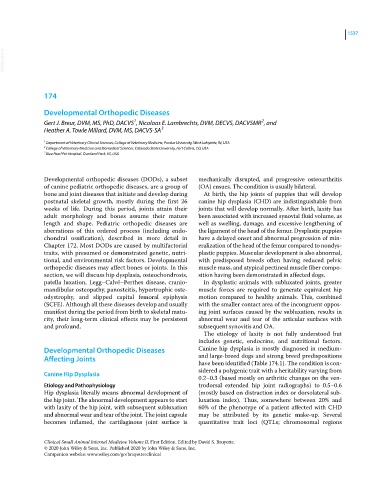Page 1599 - Clinical Small Animal Internal Medicine
P. 1599
1537
VetBooks.ir
174
Developmental Orthopedic Diseases
2
1
Gert J. Breur, DVM, MS, PhD, DACVS , Nicolaas E. Lambrechts, DVM, DECVS, DACVSMR , and
Heather A. Towle Millard, DVM, MS, DACVS-SA 3
1 Department of Veterinary Clinical Sciences, College of Veterinary Medicine, Purdue University, West Lafayette, IN, USA
2 College of Veterinary Medicine and Biomedical Sciences, Colorado State University, Fort Collins, CO, USA
3 Blue Pearl Pet Hospital, Overland Park, KS, USA
Developmental orthopedic diseases (DODs), a subset mechanically disrupted, and progressive osteoarthritis
of canine pediatric orthopedic diseases, are a group of (OA) ensues. The condition is usually bilateral.
bone and joint diseases that initiate and develop during At birth, the hip joints of puppies that will develop
postnatal skeletal growth, mostly during the first 26 canine hip dysplasia (CHD) are indistinguishable from
weeks of life. During this period, joints attain their joints that will develop normally. After birth, laxity has
adult morphology and bones assume their mature been associated with increased synovial fluid volume, as
length and shape. Pediatric orthopedic diseases are well as swelling, damage, and excessive lengthening of
aberrations of this ordered process (including endo- the ligament of the head of the femur. Dysplastic puppies
chondral ossification), described in more detail in have a delayed onset and abnormal progression of min-
Chapter 172. Most DODs are caused by multifactorial eralization of the head of the femur compared to nondys-
traits, with presumed or demonstrated genetic, nutri- plastic puppies. Muscular development is also abnormal,
tional, and environmental risk factors. Developmental with predisposed breeds often having reduced pelvic
orthopedic diseases may affect bones or joints. In this muscle mass, and atypical pectineal muscle fiber compo-
section, we will discuss hip dysplasia, osteochondrosis, sition having been demonstrated in affected dogs.
patella luxation, Legg–Calvé–Perthes disease, cranio- In dysplastic animals with subluxated joints, greater
mandibular osteopathy, panosteitis, hypertrophic oste- muscle forces are required to generate equivalent hip
odystrophy, and slipped capital femoral epiphysis motion compared to healthy animals. This, combined
(SCFE). Although all these diseases develop and usually with the smaller contact area of the incongruent oppos-
manifest during the period from birth to skeletal matu- ing joint surfaces caused by the subluxation, results in
rity, their long‐term clinical effects may be persistent abnormal wear and tear of the articular surfaces with
and profound. subsequent synovitis and OA.
The etiology of laxity is not fully understood but
includes genetic, endocrine, and nutritional factors.
Developmental Orthopedic Diseases Canine hip dysplasia is mostly diagnosed in medium‐
Affecting Joints and large‐breed dogs and strong breed predispositions
have been identified (Table 174.1). The condition is con-
sidered a polygenic trait with a heritability varying from
Canine Hip Dysplasia
0.2–0.3 (based mostly on arthritic changes on the ven-
Etiology and Pathophysiology trodorsal extended hip joint radiographs) to 0.5–0.6
Hip dysplasia literally means abnormal development of (mostly based on distraction index or dorsolateral sub-
the hip joint. The abnormal development appears to start luxation index). Thus, somewhere between 20% and
with laxity of the hip joint, with subsequent subluxation 60% of the phenotype of a patient affected with CHD
and abnormal wear and tear of the joint. The joint capsule may be attributed by its genetic make‐up. Several
becomes inflamed, the cartilaginous joint surface is quantitative trait loci (QTLs; chromosomal regions
Clinical Small Animal Internal Medicine Volume II, First Edition. Edited by David S. Bruyette.
© 2020 John Wiley & Sons, Inc. Published 2020 by John Wiley & Sons, Inc.
Companion website: www.wiley.com/go/bruyette/clinical

